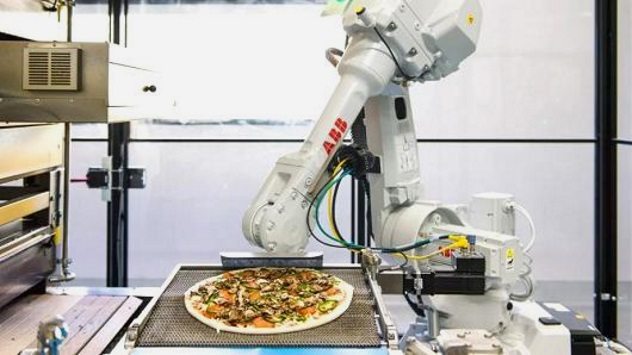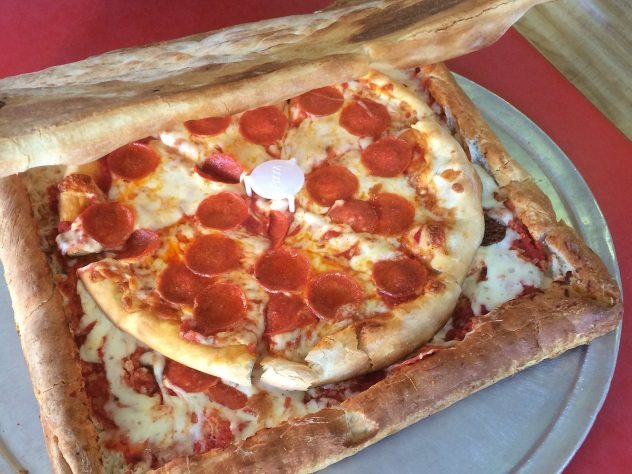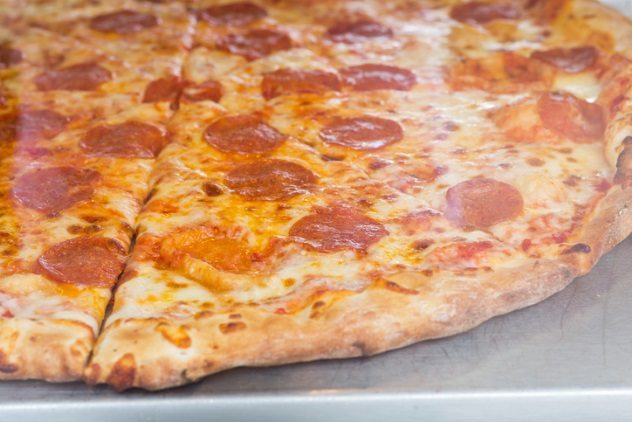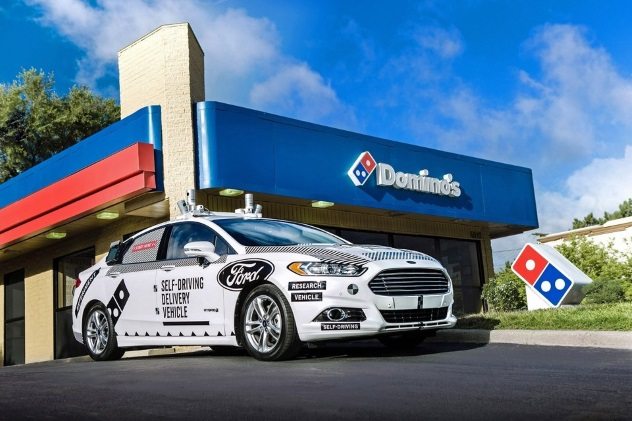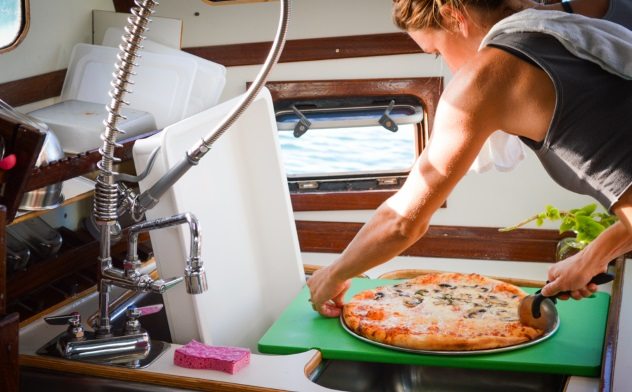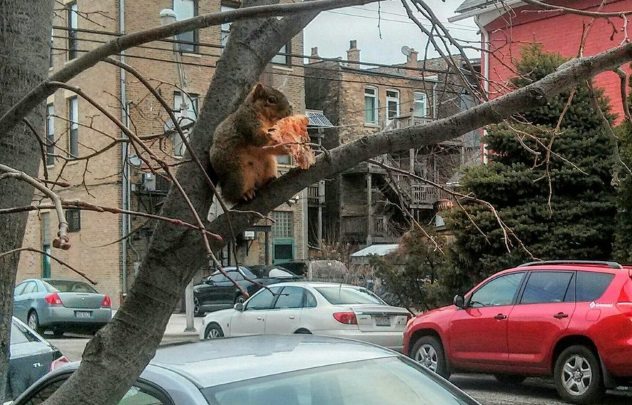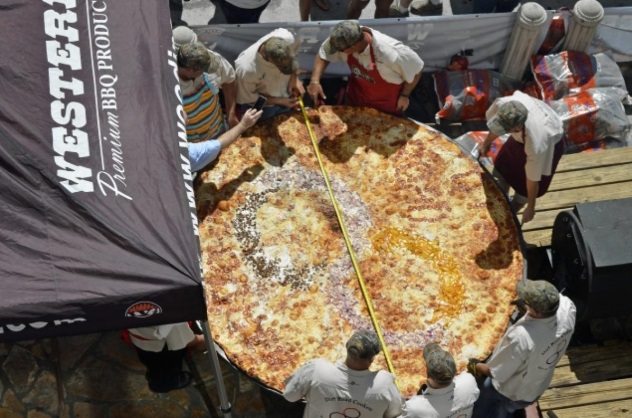Pizza is now a favorite across the planet, though how it’s made varies greatly place to place. As these ten tantalizing facts show, the dish is subject to innovation, research, study, and artistic interpretation. Even animals scrounge for, or steal, the Neapolitan taste sensation.
10 Robot Pizza Employees
Zume Pizza employs both humans and robots. Human employees help prepare the food, develop recipes, conduct taste tests, and enhance the product’s quality based on customer input. The robot workers “perform highly competitive tasks like squirting and spreading tomato sauce and placing pizzas in ovens.” Located in Mountain View, California, the company, headed by CEO Julia Collins, has set its goal at serving the entire San Francisco Bay Area by the end of 2018.[2]
9 Pizza Pizza Box
After devouring the pies made by Vinnie’s Pizzeria in Williamsburg, Brooklyn, customers can eat the boxes in which the pizzas were delivered. Inspired by the sight of empty pizza boxes in Brooklyn trash cans, co-owner Sean Berthiaume decided to make edible containers made out of pizza. During a lull in the pizzeria’s business, Berthiaume experimented with the idea.[3] For $40, customers can have the pizza-within-a-pizza box delivered to their homes or businesses. The pizza and its container are wrapped in foil and delivered in a pizza bag. (No, the bag isn’t made of pizza.) “I like to experiment,” Berthiaume admitted. Last year, one of his experiments produced a pizza topped with smaller slices of pizza.
8 Mathematical Pies And Slices
Mathematician Eugenia Cheng knows a thing or two about pizza. In 2013, she devised a formula by which to determine the ideal size for a pie. According to Cheng, the determining factor is the crust. In inventing her formula, Cheng proceeded on the basis that smaller slices have more toppings, so they taste better than larger slices with fewer toppings, and the center of the pie is thicker with toppings than the edges. As far as taste goes, thinner crusts are better than thicker crusts, because the latter decreases the bread-toppings ratio and could become soggy. PizzaExpress, a UK chain, commissioned Cheng’s project in order to ascertain why its customers preferred 36-centimeter (14 in) pies to 28-centimeter (11 in) pies. Based on Cheng’s findings, which matched customers’ tendencies to favor crispier crusts and balanced toppings, PizzaExpress added 15 grams of dough to its recipe. In other research involving the investigation of a pattern of equal-size tiles, Joel Haddley and Stephen Worsley of the University of Liverpool found “a way to slice curvy pieces with nearly an infinite number of sides (as long as it’s an odd number of sides) and then further divide those slices in half.” They came up with a more ostentatious way of achieving the same result, cutting “each slice [into] more complex shapes by creating wedges in the sides.”[4]
7 Self-Driving Pizza Delivery Vehicle
Pizzerias are going high-tech in other ways, too. Domino’s Pizza and its partner, Ford Motor Company, have set themselves the goal of delivering pizzas involving “a simulated autonomous vehicle experience” featuring a Ford Fusion hybrid. Ann Arbor City Council member Sumi Kailasapathy happened to see the driverless delivery vehicle during a test drive, and she asked the research team whether the vehicle could detect and stop for a pedestrian waiting on a curb to cross the street at a crosswalk at which there’s neither a signal nor any other people already in the crosswalk. According to the engineers, the vehicle could detect Rectangular Rapid Flashing Beacons, the signals activated by pedestrians at crosswalks equipped with them, and stop for them to cross, but they hadn’t heard of the type of crosswalks mentioned by Kailasapathy. In a follow-up e-mail, Alan Hale, a Ford spokesman, assured the city council that the vehicles could, in fact, detect pedestrians waiting to cross a street, whether the crosswalk was equipped with a signal or not, and would stop to allow them to cross the street. “When a vehicle is approaching a crosswalk, it knows it’s approaching a crosswalk, so it has specific rules to look for people in the area of the crosswalk,” he assured Kailasapathy and the other council members. The driverless delivery vehicles would also be equipped with such other detection capabilities as algorithms that can predict pedestrian behavior, radar and laser sensors, cameras covering 360 degrees, and 200-meter (660 ft) depth perception. The vehicles would also operate according to 3-D models of their environments that would include locations of roads, sidewalks, and buildings as well as such supplemental data as laws, road rules, crosswalks, traffic signals and signs, and other road markings. Ford hopes to have driverless vehicles on the road by 2021, driving people to their destinations and delivering groceries, packages, and, of course, pizza.[5]
6 Subconscious Menu
For customers who have trouble deciding what they want on their pizzas, Pizza Hut may have come up with the answer. A “subconscious menu” powered by Tobii Technology, a Swedish company, tracks customers’ eye movements as they check out various pizza toppings shown on the screen and then suggests a pie from among the 4,896 pizza combinations available. The software took six months to develop and was successful 98 percent of the time, according to results of tests that took place in the United Kingdom. If the subconscious menu proves popular among UK customers, Pizza Hut may introduce it to its American patrons.[6]
5 Floating Pizzeria
Pizza Pi is more than home to Sasha and Tara Bouis. Their 11-meter (37 ft) boat, built of quarter-inch-thick aluminum plate, is also a floating pizzeria supplying pizzas throughout the Virgin Islands. Sasha, who formerly pursued a Wall Street career, and his wife Tara, who taught elementary special education in Indiana and SCUBA lessons during summers in the Caribbean, gave up their respective careers to ply the tropical waves while supplying their gluten-free, “made-from-scratch” pizza, with “slow-fermentation New York style crust” to local residents and vacationing tourists. Tara designed, renovated, and built the boat herself. Besides the wind in her sails, the boat is powered by a Perkins 4.236 engine. A menu hangs down its side, listing Plain Jane, Mad Shroom, and Sweet Home pizzas, among other fare, and their respective prices, as well as pies made to order. Although the boat never docks, there’s a window through which transactions can occur between Pizza Pi and customers’ boats, and the couple delivers within the confines of Christmas Cove.[7] Hunger inspired the idea for their business. “We were sitting on a boat right here in Christmas Cove,” Sasha recalled, “watching the sunset, and I got hungry.” The presence of tourists suggested that a “pizza boat” could do well, Tara said, so she got to work renovating an old boat to her specifications, while Sasha worked on the engine. Termites helped by consuming the “entire interior” of the boat, leaving Tara with a “perfect blank slate.” To learn about building the boat and running a restaurant, they watched “tons of YouTubes,” Tara said. On a busy day, the couple sell as many as 70 pies as well as alcoholic beverages and desserts. To toss the pizza dough in the cramped galley, Tara has to kneel. Their 22-month-old daughter, Fiona, acts as their public relations agent, chatting with the crowd, who calls her “Pizza Baby” while chowing down on the family’s product.
4 Animal Pizza Lovers
Included among devotees of pizza are some rather furry aficionados. One, dubbed “Pizza Rat” by New Yorkers, scavenges the city’s subway stations, collecting discarded pizza slices. Possession doesn’t necessarily secure ownership, though, and Pizza Rat sometimes has to fend off other rodents intent on stealing his slice of the pie. A brawl between Pizza Rat and rivals, captured by a subway rider, shows Pizza Rat dragging a slice of pizza downstairs and into a fenced-off area, where he’s ambushed by two other rats. A tug of war ensues between the hungry rodents. This time, it appears Pizza Rat loses the contest.[8] “Pizza Squirrel” is another rodent that enjoys pizza. A Chicagoan, Pizza Squirrel forages among the garbage of the city’s Ukranian Village for his slices, which he enjoys perched on the branch of a neighborhood tree. Andrew Goodman, the Chicago resident who snapped the rodent’s picture, said, “It was exactly like the pizza rat, except he was hopping.” The photo made its rounds on the Internet after Andrew’s friend, Melissa McEwan, posted it on Twitter. Another animal who enjoys pizza stole, rather than scavenged, his meal. The sly fox, noting an unattended parked van with its passenger-side door open, leaped into the front of the vehicle, snatched a slice of pizza, and hastened off with his loot, thereby earning the nickname “Pizza Fox.”
3 Pizza Farm
When Naomi Paley and Rachel Kraynick, regional farm business management specialist with the Saskatchewan Ministry of Agriculture in Yorkton, agreed to establish their pizza farm, they worked with with several industry groups, Kraynick said. The farm is circular in shape, its field divided into ten wedges, each of which is dedicated to the cultivation of a different ingredient for pizza toppings. Plots are dedicated to onions, basil and oregano, tomatoes, peppers, garlic, and other pizza ingredients, Paley said, including the cheese produced from cows’ milk (represented in the farm’s “pie” by a “slice” of pasture) and the ham produced from hogs occupying another “slice” of pasture. Third- and fourth-grade students, who’ve already learned about soils and plants, visit the farm for hands-on instruction about “the importance of technology to production,” the nutrients plants need, the use of chemicals in agriculture, and environmental awareness. There are worries about the use of herbicides, chemicals, and fertilizers, Paley said, but the farm’s “side-by-side slices will show how such things improve crop health and production.” The pizza farm also provides work for Whitespruce residents who’ve been convicted of crimes, the sentences for which include community service. During the summer, they water and weed the slices of the pizza farm’s pie.[9]
2 Pizza Art Exhibit
Oto Gillen made his pizza (pictured above) from UV glass, mahogany, and screws, serving up his pie on a mat board, while John Freeman and Justin Lowe used a single ingredient: papier-mache, which, in French, appropriately enough, means “chewed paper.” Gillen, Freeman, and Lowe are among the other artists who contributed works to PIZZA TIME!, the first show of Manhattan’s Marlborough Broome Street Gallery, which featured over 25 works of pizza-inspired art. Curator Vera Neykov described pizza as a “metaphor for community.” A food that’s “not too fussy,” it unites communities, she said. John Riepenhoff’s conceptual piece, Physical Pizza Networking Theory, was a 97-centimeter (38 in) pie that was itself topped by smaller pizzas. An interactive exhibit, Riepenhoff’s work, cooked by a local pizzeria, was consumed on opening night by the gallery’s visitors. The artist described the pizza as a “collage [that] address[es] the ontology of the social as material in art.” Other works on exhibit include Michelle Devereux’s Caveman on Pizza and Dude on Pizza #6 ; Andrew Kuo’s Slice 8/23/13 and Piece/Peace, which depicted slices “in geometric shards and colorful smears”; and Will Boone’s Brothers Pizza, which shows the eerie effect achieved by photocopying a pizza.[10]
1 Gigantic Pizza
The Dirt Road Cookers, a group of eight caterers located in San Antonio, Texas, joined forces to create the world’s largest pizza. The result was a 4.3-square-meter (46.6 ft2), 45-kilogram (100 lb) pie with a 235-centimeter (92.5 in) diameter. Head chef Kurt Oefinger said that baking the pie was truly a team effort. He supervised. Another team member tended the fire. Two others prepared the toppings. Another pair worked on the pizza’s base. Two more supplied water to the other thirsty workers. “It gets hot,” Oefinger said. It took the group an hour and 45 minutes to complete the task. It also took a year to build the necessary equipment to cook the pizza. Despite their efforts and some claims that the pizza was the largest ever made, Guinness World Records recognizes a much larger, 1,261.7-square-meter (13,580.3 ft2) pizza made in Rome in 2012 as the record holder.[11] The Dirt Road Cookers’ pizza would still be a daunting sight for even the most hardened eating contest veteran, however.
